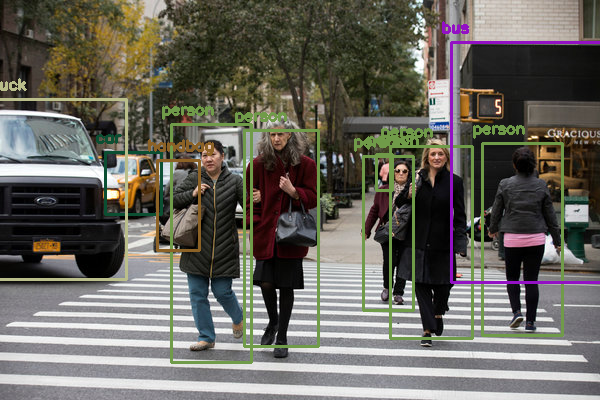OpenCV3与深度学习实例-使用YOLOV3进行物体检测
2018-09-12 11:49
1086 查看
import cv2
import argparse
import numpy as np
ap = argparse.ArgumentParser()
ap.add_argument('-i', '--image', required=False,default='datas/images/people.jpg',
help = 'path to input image')
ap.add_argument('-c', '--config', required=False,default='datas/models/yolov3/yolov3.cfg',
help = 'path to yolo config file')
ap.add_argument('-w', '--weights', required=False,default='datas/models/yolov3/yolov3.weights',
help = 'path to yolo pre-trained weights')
ap.add_argument('-cl', '--classes', required=False,default='datas/models/yolov3/yolov3.txt',
help = 'path to text file containing class names')
args = ap.parse_args()
def get_output_layers(net):
layer_names = net.getLayerNames()
output_layers = [layer_names[i[0] - 1] for i in net.getUnconnectedOutLayers()]
return output_layers
def draw_prediction(img, class_id, confidence, x, y, x_plus_w, y_plus_h):
label = str(classes[class_id])
color = COLORS[class_id]
cv2.rectangle(img, (x,y), (x_plus_w,y_plus_h), color, 2)
cv2.putText(img, label, (x-10,y-10), cv2.FONT_HERSHEY_SIMPLEX, 0.5, color, 2)
image = cv2.imread(args.image)
Width = image.shape[1]
Height = image.shape[0]
scale = 0.00392
classes = None
with open(args.classes, 'r') as f:
classes = [line.strip() for line in f.readlines()]
COLORS = np.random.uniform(0, 255, size=(len(classes), 3))
net = cv2.dnn.readNet(args.weights, args.config)
blob = cv2.dnn.blobFromImage(image, scale, (416,416), (0,0,0), True, crop=False)
net.setInput(blob)
outs = net.forward(get_output_layers(net))
class_ids = []
confidences = []
boxes = []
conf_threshold = 0.5
nms_threshold = 0.4
for out in outs:
for detection in out:
scores = detection[5:]
class_id = np.argmax(scores)
confidence = scores[class_id]
if confidence > 0.5:
center_x = int(detection[0] * Width)
center_y = int(detection[1] * Height)
w = int(detection[2] * Width)
h = int(detection[3] * Height)
x = center_x - w / 2
y = center_y - h / 2
class_ids.append(class_id)
confidences.append(float(confidence))
boxes.append([x, y, w, h])
indices = cv2.dnn.NMSBoxes(boxes, confidences, conf_threshold, nms_threshold)
for i in indices:
i = i[0]
box = boxes[i]
x = box[0]
y = box[1]
w = box[2]
h = box[3]
draw_prediction(image, class_ids[i], confidences[i], round(x), round(y), round(x+w), round(y+h))
cv2.imshow("object detection", image)
cv2.waitKey()
# cv2.imwrite("object-detection.jpg", image)
cv2.destroyAllWindows()
相关文章推荐
- OpenCV3与深度学习实例-使用SSD Inception模型进行物体检测
- OpenCV3与深度学习实例-使用GoogLeNet模型进行图片分类识别
- OpenCV3与深度学习实例-使用OpenPose进行人体姿态估算
- OpenCV之feature2d 模块. 2D特征框架(2)特征描述 使用FLANN进行特征点匹配 使用二维特征点(Features2D)和单映射(Homography)寻找已知物体 平面物体检测
- 深度学习笔记之使用Faster-Rcnn进行目标检测 (实践篇)
- 深度学习之物体检测——YOLO(二)_用作者提供的YOLO实现进行检测
- 使用亚马逊AWS云服务器进行深度学习——免环境配置/GPU支持/Keras/TensorFlow/OpenCV
- iOS开发之opencv学习笔记二:使用CascadeClassifier进行对特定物体的跟踪
- 深度学习笔记之使用Faster-Rcnn进行目标检测 (实践篇)
- 深度学习笔记之使用Faster-Rcnn进行目标检测 (原理篇)
- 苹果最新机器学习论文:使用VoxelNet进行3D物体检测
- 深度学习Caffe平台实例——CIFAR-10数据集在caffe平台上模型训练及实例使用模型进行预测
- 使用深度学习Caffe框架的C++接口进行物体分类
- python中使用OpenCV进行人脸检测的例子
- 【OpenCV学习笔记】【编程实例】六 (霍夫圆检测续)
- 【OpenCV学习笔记】【编程实例】五 (霍夫圆检测)
- OpenCV学习笔记(8)VS2008 MFC下使用OpenCV2.0进行简单图像处理
- OpenCV中特征检测,提取与匹配使用方法学习
- java struts2入门学习实例--使用struts进行验证
- java struts2入门学习实例--使用struts进行验证
